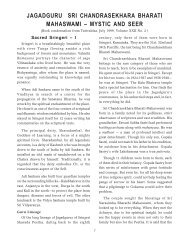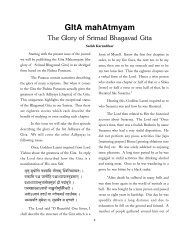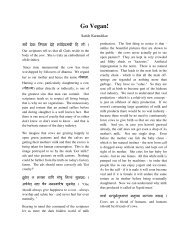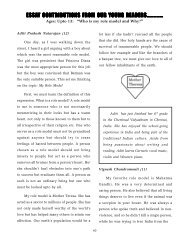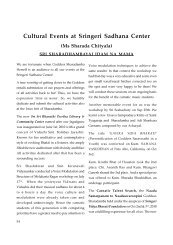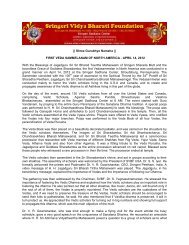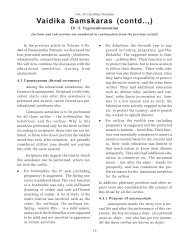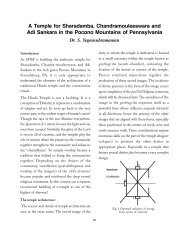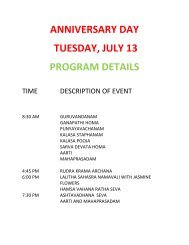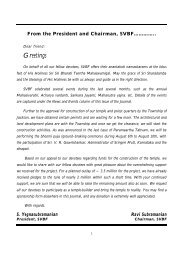Taittiriya Upanishad - Siksha Valli - Sringeri Vidya Bharati Foundation
Taittiriya Upanishad - Siksha Valli - Sringeri Vidya Bharati Foundation
Taittiriya Upanishad - Siksha Valli - Sringeri Vidya Bharati Foundation
You also want an ePaper? Increase the reach of your titles
YUMPU automatically turns print PDFs into web optimized ePapers that Google loves.
TAITTIRIYA UPANISHAD – SIKSHA VALLI<br />
Abhiram Vijaya Sarathy (18)<br />
(Project report submitted by Abhiram as an SVBF Internship student under the auspices<br />
of the Academy for the Advancement of Science and Technology, Bergen County, NJ)<br />
Preface<br />
As a high school (12 th grade) senior at the<br />
Academy for the Advancement of Science and<br />
Technology, Bergen County, NJ, I had to go<br />
through a program known as Senior<br />
Experience. Through this program students are<br />
required to engage in an internship during<br />
Wednesdays of their senior year. At the same<br />
time, I had started to receive the journal<br />
Paramaartha Tattvam published by SVBF, which<br />
propagates the Vedic culture. By reading<br />
various articles such as those in this journal,<br />
along with the encouragement of my Aunt Sri<br />
Lakshmi, I became captivated with philosophy<br />
and Vedanta. As a result, I contacted Dr. S.<br />
Yegnasubramanian, President of SVBF and<br />
Editor of Paramaartha Tattvam, and was able<br />
to secure an enlightening and gratifying<br />
internship at SVBF.<br />
After completing my internship at SVBF, I<br />
was inspired to further my study of Vedanta and<br />
the Hindu lifestyle. Furthermore, during this<br />
study of <strong>Siksha</strong> <strong>Valli</strong>, I was fascinated with the<br />
student – teacher relationship, which is<br />
elucidated throughout this section. As a result<br />
of my captivation, I was motivated to stay at<br />
<strong>Sringeri</strong> during the summer, where I hope to<br />
experience this spiritual relationship firsthand.<br />
At <strong>Sringeri</strong>, I look forward to the divine fortune<br />
of meeting our guru, Sri Sri <strong>Bharati</strong> Tirtha<br />
Mahaswamigal, and will have a wonderful<br />
opportunity to observe in close quarters the<br />
study of Vedic scriptures by the students of the<br />
Patasala (Vedic school). I greatly enjoyed my<br />
internship at SVBF, and am looking forward to<br />
my visit and stay at <strong>Sringeri</strong>. I strongly suggest<br />
to anyone who has an interest in the study of<br />
our scriptures to undergo this form of internship<br />
at SVBF. It will be a truly remarkable experience,<br />
through which one may gain knowledge of our<br />
scriptures from an exceptional teacher such as<br />
Dr. Yegnasubramanian.<br />
To my guru<br />
Dr. S. Yegnasubramanian<br />
For his dedication to the propagation of<br />
Vedic Knowledge<br />
Introduction<br />
Hindus have been recognized throughout<br />
the world for their rich culture and traditions.<br />
They are acclaimed for their meticulous<br />
preservation of the Sanatana Dharma, which<br />
has been the way of life practiced for thousands<br />
of years, based on the Vedas or the ancient<br />
Hindu scriptures. The Vedas have existed in the<br />
form of vibrations since the beginning of the<br />
universe. The rsis (sages) were able to receive<br />
and understand these vibrations through<br />
meditation, and so the Vedas are believed to<br />
be of non-human origin. The word veda is<br />
derived from the Sanskrit root vid which means<br />
“to know.” Since Hinduism follows the Vedic<br />
Injunctions, it is known as the “Vedic Religion.”<br />
In this case the word religion implies the<br />
meaning of dharma. What is dharma? Scholars<br />
consider dharma as that which, when followed,<br />
brings contentment and happiness. The texts<br />
that give us the complete knowledge of dharma<br />
are called dharma pramana. They are fourteen<br />
in number, including four Vedas (Rg, Yajur -<br />
which is further divided into Krishna Yajur Veda<br />
and Sukla Yajur Veda- Sama, and Atharva), six<br />
Vedangas or organs of the Vedas (<strong>Siksha</strong>,<br />
Vyakarana, Chandas, Nirukta, Jyotisha, and<br />
12
Kalpa) and four Upangas or secondary organs<br />
of the Vedas (Mimamsa, Nyaya, Purana, and<br />
Dharma Sastra). These fourteen texts are<br />
glorified as the <strong>Vidya</strong>sthanas or the abode of<br />
true knowledge and wisdom.<br />
Among the Vedas, Rg Veda sets forth the<br />
Vedic principles of knowledge, Yajur Veda shows<br />
the Vedic way of action and the importance of<br />
rituals, Sama Veda glorifies the Vedic way of<br />
ecstasy and Atharva Veda speaks about several<br />
other vidyas and supplementary principles of<br />
knowledge. As codified by Sage Veda Vyasa,<br />
Rg Veda had 21 sakhas (recensions), Yajus had<br />
101 sakhas, Sama had 1000 sakhas, and<br />
Atharva Veda had 9 sakhas, totaling 1,131<br />
sakhas. However, only 10 sakhas are available<br />
to us today!<br />
Among Vedangas, <strong>Siksha</strong> deals with<br />
pronunciation and euphony, Vyakarna with<br />
grammar, Chandas with meter and poetry,<br />
Nirukta with etymology, Jyotisha with astronomy,<br />
and Kalpa with the procedural aspects of Vedic<br />
karmas. Among Upangas, Mimamsa deals with<br />
the action and knowledge based interpretations<br />
of the Vedic texts, Nyaya with logic, Purana with<br />
mythology (Puranas serve as a magnifying glass<br />
of the Vedic Injunctions), and Dharma Sastras<br />
with Vedic codes of conduct.<br />
The Vedic literature can be classified into<br />
four groups: 1. Samhita: mantra portion;<br />
2. Bhramanas: portion dealing with rituals;<br />
3. Aranyakas: the forest texts; and,<br />
4. <strong>Upanishad</strong>s: portion dealing with Vedic<br />
philosophy. The principles of dharma as<br />
embodied in our religion are all centered around<br />
the Vedas.<br />
The scriptures deal with two different margas<br />
or paths to the ultimate Truth: the jnana marga<br />
or the path of knowledge, and the karma marga<br />
or the path of action. The <strong>Upanishad</strong>s, which<br />
are placed at the end of the Aranyakas, deal<br />
with realizing through the jnana marga and are<br />
often considered the quintessence of the Vedas.<br />
One commonly researched and discussed<br />
<strong>Upanishad</strong> in Krishna Yajur Veda is the <strong>Taittiriya</strong><br />
<strong>Upanishad</strong>. This <strong>Upanishad</strong> is divided into three<br />
chapters, <strong>Siksha</strong> <strong>Valli</strong>, Brahmananda <strong>Valli</strong>, and<br />
Bhrigu <strong>Valli</strong>. The latter two chapters focus on<br />
deep philosophy and therefore require some<br />
previous learning of basic vedantic principles,<br />
while the first chapter gives an introduction to<br />
Vedanta and the teacher – student relationship.<br />
In this chapter we see the manner in which a<br />
teacher initiates his student into Brahma <strong>Vidya</strong><br />
or study of the Self. As a result this is the ideal<br />
starting point for a student interested in studying<br />
philosophy, especially if he is also born into a<br />
family of the Krishna Yagur Veda, as myself.<br />
Time and time again we have been blessed<br />
with great leaders such as Sankaracharya,<br />
Ramanujacharya, Madvacharya, and<br />
Ramakrishna Paramahamsa to guide us through<br />
difficulties. Whenever we have faced the fear<br />
of the collapse of our religion, we have had a<br />
powerful leader who could restore its stability.<br />
Perhaps the best example is that of<br />
Sri Adi Sankaracharya. During Sankara’s time,<br />
many Indians, due to both internal and external<br />
reasons, had started to renounce the precedence<br />
of the Vedas. However, Sankara, one of the<br />
greatest philosophers of all times, was able to<br />
prevent the complete destruction of the Hindu<br />
culture. In fact, through various means such as<br />
the writing of comprehensive commentaries on<br />
numerous <strong>Upanishad</strong>s, the Bhagavad Gita, the<br />
Brahma Sutras, etc., he was actually able to<br />
strengthen the culture’s foundation.<br />
The manner in which our ancestors have<br />
safeguarded the Hindu way of life is truly<br />
remarkable. We must note their great efforts and<br />
try to continue their cause by furnishing an<br />
adequate teaching of their traditional values for<br />
future generations.<br />
17
<strong>Siksha</strong> <strong>Valli</strong><br />
Chapter I: Peace Invocation<br />
In this opening chapter, the student asks for<br />
blessings from various deities including Mitra,<br />
Varuna, Aryama, Indra, Brhaspati, and Vishnu.<br />
These deities preside over the incoming breath<br />
and the day, the outgoing breath and the night,<br />
the sun and the eyes, strength, intellect, and<br />
movement respectively. By requesting all these<br />
deities for benediction he hopes to ensure that<br />
all aspects of his education will go smoothly.<br />
The student says that he will look upon<br />
Vayu, the deity of the wind, as the visible<br />
Brahman. That is, the tangible Vayu will<br />
symbolize the intangible Brahman during his<br />
Vedic lessons. He asks this Vayu to provide him<br />
with the optimal mental and physical conditions<br />
for performing the study of transcendental<br />
knowledge. He asks first for protection for<br />
himself so that he may continue his Vedantic<br />
learning without illness, can maintain a clear<br />
mind, can stay focused on the material at hand<br />
without falling to other attractions, and has the<br />
ability to understand and retain the lessons that<br />
the teacher has taught him. Then, he proceeds<br />
to ask Vayu to protect his teacher as well. He<br />
wants to assure that his teacher has the physical<br />
strength to teach the lessons, does not make any<br />
oral mistakes while teaching, and is able to<br />
clearly explain the Vedic knowledge. Only under<br />
such conditions and a serene environment, will<br />
the student be able to make great spiritual<br />
advancements.<br />
Finally, the student asks for peace three<br />
times. By doing so, he wants to remove all<br />
possible forms of obstacles that may hinder his<br />
lessons. These include those caused by divine<br />
powers, those caused by others (external), and<br />
those caused by the student himself (internal).<br />
Once assured that none of these will obstruct<br />
his quest for transcendental knowledge, he<br />
prepares to commence his study.<br />
Chapter II: Pronunciation<br />
In Chapter II the teacher starts the series of<br />
lessons by explaining to the student the<br />
importance of pronunciation (which includes<br />
sound, pitch, duration, force, modulation, and<br />
combination). However, as the student is<br />
already well versed in Vedic recitation, the<br />
teacher does not go into much depth in this<br />
chapter. Rather, he simply states the importance<br />
of pronunciation, and this entire section acts as<br />
a mere reminder to the student. It is not only<br />
important for the student to understand the<br />
meaning of the texts, but it is also important for<br />
him to recite them correctly. The lack of<br />
perfection in any one of the areas of<br />
pronunciation could have severe effects upon<br />
the meaning of the statements. As a result, he<br />
cannot neglect the significance of pronunciation<br />
while undertaking this study. Only after learning<br />
proper pronunciation from a qualified teacher,<br />
and proving his skills, can he actually administer<br />
Vedic recitation.<br />
Chapter III: Meditations on the<br />
Combinations<br />
The student asks Brahman to bless him with<br />
the Vedic knowledge, and his teacher, with the<br />
ability to teach this knowledge. The teacher<br />
proceeds to teach the student about the method<br />
of Upasana (meditation). Through Upasana the<br />
student is able to develop his concentration by<br />
focusing on a particular object or relationship.<br />
The teacher describes a manner of Upasana that<br />
deals with four parts, the prior form, the<br />
posterior form, the intermediate form, and the<br />
connection.<br />
At this time the student is familiar with the<br />
Sanskrit language, as he has just finished his<br />
lessons in that field. As a result, the teacher<br />
teaches him a form of this Upasana that deals<br />
with fundamentally the same concepts as the<br />
combination of letters in Sanskrit. The student<br />
can easily understand this form of Upasana and<br />
14
therefore can use this “warm-up” to adapt to<br />
more complex forms of Upasana. Then the<br />
teacher explains an Upasana on the universe,<br />
then the luminaries, then on the “learning” of<br />
these lessons, then on progeny, and finally on<br />
the individual. During the Upasana of the<br />
universe the student is taught to look upon the<br />
earth as the prior form, the heaven as the<br />
posterior form, the atmosphere as the<br />
intermediate form, and the air as the<br />
connection. This Upasana quickly reduces the<br />
student’s arrogance. It sensitizes him to such an<br />
immense world external to him. All of his<br />
thoughts and worries become trivial as he<br />
considers their place in the entire cosmos.<br />
However, at the same time, this Upasana also<br />
expands the student’s mind. Trying to do<br />
Upasana on the entire universe allows him to<br />
look upon himself as part of a vast world, there<br />
by getting him closer to the realization of<br />
Brahman.<br />
Next they move on to the Upasana of the<br />
luminaries. They view fire as the prior form, the<br />
sun as the posterior form, water as the<br />
intermediate form and lightning as the<br />
connection. Through this Upasana the student<br />
realizes that the content of fire and the content<br />
of the sun are the same, namely energy.<br />
However, the only difference between the<br />
energy in the sun and the energy in the fire is<br />
that the fire exists on the earth while the energy<br />
in the sun is present in the skies. Now, if he<br />
continues this same reasoning he can come to<br />
understand that, although there is such a great<br />
distance separating him from Brahman, the<br />
contents of his Atma and Brahman are the<br />
same.<br />
The next part looks upon the teacher as the<br />
prior from, the student as the posterior form,<br />
the process of learning as the intermediate form,<br />
and instruction as the connection. Then the<br />
student proceeds to learn about the Upasana<br />
on progeny. The mother is viewed as the prior<br />
form, the father is the posterior form, the<br />
progeny is the intermediate form, and the<br />
process of creation is the connection. Finally<br />
the teacher teaches the student the Upasana on<br />
the individual. Here, the lower jaw is the prior<br />
form, the upper jaw is the posterior form, speech<br />
is the intermediate form, and the tongue is the<br />
connection. This is a crucial, although simple,<br />
Upasana for the student. Since speech is<br />
common to the student, this Upasana is easily<br />
performed. Nevertheless, it forces the student<br />
to see the importance of speech, which is the<br />
center of all communication and therefore the<br />
center of knowledge.<br />
By looking at the sequence in which these<br />
lessons are taught, we observe that the objects<br />
of Upasana tend to get closer to the student<br />
himself. First he meditates on the universe and<br />
the luminaries which are distant, then he<br />
meditates upon knowledge and progeny which<br />
are somewhat closer to him, and finally he<br />
meditates on speech which is a part of him. He<br />
starts by meditating on that which is external<br />
and gradually moves towards meditation on<br />
that which is internal. This is more than a simple<br />
coincidence. By teaching this method of<br />
Upasana to the student, the teacher encourages<br />
the student to develop a deeper understanding<br />
of the relationship between the outside world<br />
and the self that is within. As the student tones<br />
this understanding, he will come to realize that<br />
both the outside world and the “inside world”<br />
are the same.<br />
Chapter IV: Wisdom and Fortune<br />
In this chapter, the student asks Om, the<br />
symbol of Brahman, to bless him with great<br />
memory, strength, the ability to speak wisely,<br />
and the privilege of hearing “abundantly”. Now<br />
that he is engaging in this transcendental study,<br />
he must be able to retain all that he learns. If he<br />
is unable to do so, all his studies will be wasted,<br />
and his spiritual level will not improve. At the<br />
same time, he wants to continue his learning<br />
and continue his progress, and so, asks “to hear<br />
15
in plenty”. However, after learning, he must do<br />
his duty of enlightening others, and therefore<br />
asks for the ability to speak wisely. In this process<br />
he does not want to offend others or to<br />
compromise the truth in his speech, and in order<br />
to ensure both of these, he asks specifically for<br />
“sweet” and “agreeable” speech. He believes<br />
that these blessings will in turn allow him to<br />
carry out the study of Brahman to his full<br />
potential.<br />
The second part of the chapter deals with<br />
the student’s requests after obtaining knowledge<br />
(this is known as the Avahanti Homam). He asks<br />
for wealth, fame, leadership, clothes, food,<br />
drink, prosperity, cattle, and students<br />
(Brahmacharins) who observe self-control and<br />
are peaceful. After doing so, he asks for success,<br />
more students, and finally for the merger with<br />
Brahman. It is interesting to note that the<br />
student waits until he is knowledgeable before<br />
asking for these items. He does not want money,<br />
fame, etc. before he knows how to use them<br />
positively or appropriately. If an ignorant man<br />
is given money he will just waste it and once<br />
again become poor. As a result, the student<br />
decides to attain knowledge first and asks for<br />
prosperity afterwards.<br />
However, one might question the student’s<br />
“desires.” Why would the student, who has<br />
already gone through the study of Brahma-<br />
<strong>Vidya</strong>, ask for material objects such as food,<br />
clothing, and wealth? This becomes clear once<br />
we consider the enlightened student’s<br />
responsibility. He must pass on his knowledge<br />
to others, and so he asks for students to come<br />
to him from all directions. But, if this is to<br />
happen, he must be equipped with enough<br />
food, clothing, and shelter, in order to protect<br />
his students, a major commitment for teachers<br />
in the Gurukula system of education. By asking<br />
for these objects the seeker of knowledge does<br />
not necessarily show any attachment to the<br />
objects themselves, but rather upon their<br />
purpose, to allow him to fulfill his duty of Vedic<br />
propagation. These objects act solely as sources<br />
that will facilitate his attainment of Brahman,<br />
and as a result, do not hinder his progress.<br />
Chapter V: Mystical Utterances<br />
This chapter deals with the four major<br />
mystical utterances, Bhuh, Bhuvah, Suvah, and<br />
the ultimate utterance, Mahah. The first three are<br />
viewed as limbs of a body while Mahah is viewed<br />
as the body itself (consisting of both the major<br />
body and the limbs). As a result, Mahah, which<br />
consists of all, is looked upon as Brahman, the<br />
Infinite. The four utterances are examined in<br />
various angles. Once again, we can notice the<br />
gradual motion from “external towards internal.”<br />
During the initial approaches towards this form<br />
of Upasana the teacher provides objects which<br />
are external to the student. However, as they<br />
progress, he provides the student with objects<br />
that the student can easily relate to. These latter<br />
objects are more familiar to the student and can<br />
be viewed as pertaining to “internal” knowledge.<br />
The reasoning for this progression, as before, is<br />
because the teacher wants the student to<br />
understand the synergy of that which is outside<br />
and that which is inside.<br />
First the student is told to view Bhuh as the<br />
world, Bhuvah as the sky, Suvah as the next<br />
world, and Mahah as the sun. This is because<br />
the sun is the source of energy. Without this sun,<br />
all the other three would not exist. Next the<br />
student should look upon Bhuh as fire, Bhuvah<br />
as air, Suvah as the sun, Mahah as the moon.<br />
The moon is commonly looked upon as the<br />
source of all “vitality.” As a result it is looked upon<br />
as Mahah. The sun, although it was looked upon<br />
as Mahah in the previous Upasana, is looked<br />
upon as Suvah in this Upasana. This can be<br />
easily explained by looking at the subject of this<br />
Upasana. That is, in the previous case the student<br />
was doing Upasana on the sun as the source of<br />
energy, but in this case, he is looking upon a<br />
different aspect of the sun, with reference to<br />
“vitality,” which is inferior in degree to the same<br />
16
aspect existent in the moon. Next, the teacher<br />
tells the student to view Bhuh as prana, Bhuvah<br />
as apana, Suvah as samana, and Mahah as<br />
food. This Upasana is simple in that the student<br />
can easily understand that food is sustainer of<br />
life. Without food, one would not have any<br />
energy and therefore would not experience<br />
prana, apana, or samana. One who<br />
understands the true meanings of these four<br />
four-fold Upasanas has attained Brahman.<br />
Chapter VI: The Abode of Brahman<br />
This chapter tells us that one should<br />
meditate upon Brahman as a luminary part<br />
inside the heart. It also describes the Sushumna<br />
Naadi, the path from the heart to the point on<br />
the head where the hair parts. This path is<br />
looked upon as the doorway to realization.<br />
One’s soul must pass through this path as he<br />
progresses in his spiritual level. The second part<br />
of this section deals with the four mystic<br />
utterances. It states that through the utterance<br />
of Bhuh one exists in fire, through Bhuvah one<br />
exists in air, through Suvah one exists in the<br />
sun, and finally through the utterance of Mahah<br />
one realizes that he exists in Brahman. That is,<br />
as one utters each one of the expressions, he<br />
realizes the unity between himself and each one<br />
of the physical beings such as the fire, air, and<br />
sun. Finally, after realizing that his true nature is<br />
the same as that of fire, air, and the sun, he<br />
comes to understand the unity between this<br />
“nature” and the nature of the Infinite, or<br />
Brahman, with the utterance of Mahah.<br />
Finally, the third part of this section deals<br />
with the seeker’s lordship over its faculties of<br />
mind, speech, eyes, ears, and eventually<br />
knowledge. This shows that one must first learn<br />
to develop self-control over his senses such as<br />
speech, sight, and hearing, and have strict<br />
authority over his mind, before he can truly<br />
come to realize Brahman, or comprehend the<br />
ultimate Truth.<br />
Chapter VII: Five-fold Nature of the World<br />
This chapter teaches the student a pentadic<br />
or five-fold manner of meditation. By meditating<br />
on the five-fold nature of the outside world and<br />
then meditating on the five-fold nature of the<br />
inner self, one gradually realizes the oneness of<br />
the two. We have seen this gradual movement<br />
from “external towards internal” in many of the<br />
other forms of meditation as well. In this case<br />
the student first views the earth, the<br />
antariksham, the sky, the main quarters, and<br />
the intermediate quarters as the five parts of<br />
matter. Then he looks at fire, air, the sun, the<br />
moon, and the stars as the five parts of the<br />
“world of elements.” Next he observes the five<br />
parts of nature, water, herbs, trees, space, and<br />
the soul. From there he proceeds to look upon<br />
the five parts dealing with the soul, prana,<br />
vyana, apana, udana, and samana. Then he<br />
notices the senses, eyes, ears, mind, speech, and<br />
touch. Finally, he analyzes the five parts of the<br />
body, skin, flesh, muscle, bone, and marrow.<br />
Realizing that all aspects of the world can be<br />
classified into five element subsets, he sees the<br />
connection between the five fold grouping of<br />
his body and soul, and the five fold grouping of<br />
the universe, which helps him to grasp the<br />
concept of Brahman.<br />
Chapter VIII: Om<br />
Om is a symbol of Brahman. Meditation on<br />
Brahman in combination with the recitation of<br />
Om is the method used by more sophisticated<br />
students seeking to attain knowledge. The three<br />
sounds in Om, the A, U, and M, represent the<br />
three different levels or stages of consciousness,<br />
the conscious or wakeful stage, the dream stage,<br />
and the deep sleep stage. Although all of us go<br />
through these three stages daily, we usually<br />
meditate only upon subjects dealing with the<br />
wakeful stage. By doing so, we cannot possibly<br />
attain complete knowledge. As a result, we must<br />
meditate on Om, which allows us to analyze all<br />
21
the three different stages. Finally, through the<br />
analysis of all of our experiences in all the three<br />
stages, we can come to attain Enlightenment.<br />
As he utters the phrase Om, the student<br />
meditates upon Brahman, and in doing so<br />
attains Brahman. The reason “Om” is used<br />
here as the symbol of Brahman is because it is<br />
said to contain all of sound, and is said to be<br />
the basis or root of all words, and since words<br />
are our essential means of describing and<br />
understanding this world, the union of these<br />
words- “Om” - is looked upon as Brahman.<br />
Om is used regularly in nearly all kinds of Vedic<br />
activities. For example, it is the phrase used by<br />
the respective priests of the four vedas to<br />
indicate approval during oblations, used by the<br />
teachers at the commencement of teaching and<br />
by the students while studying, and so on. By<br />
using this phrase when performing these tasks,<br />
a person, through this meditation on Om and<br />
its significance, eventually reaches Brahman.<br />
Chapter IX: Disciplines<br />
The ninth chapter establishes the<br />
importance of performing one’s duties. Even<br />
if one is constantly contemplating Brahman<br />
and reciting Om, he must not neglect the<br />
performance of his obligatory duties. The<br />
former does not permit one to terminate the<br />
latter, but instead, is strengthened when the<br />
person performs the latter to the best of his<br />
abilities. The teacher tells the student to do that<br />
which is right, speak only the truth, exercise<br />
self-control and austerities, give offerings in<br />
ritualistic fire sacrifices, feel repentance for<br />
wrong doing, remain peaceful and calm in all<br />
conditions, treat guests appropriately, do one’s<br />
duty towards children, grandchildren,<br />
humanity, and society in the proper manner,<br />
continue the family lineage, and most<br />
importantly, continue the process of learning<br />
and teaching the Vedic texts.<br />
At this crucial point, after teaching the<br />
student various methods of Upasana and a<br />
great deal about Brahman, the teacher strongly<br />
emphasizes the significance of other aspects<br />
of life, mainly his duties. When the student does<br />
these with devotion, all obstacles in his path to<br />
Knowledge will be alleviated, allowing him to<br />
progress faster. By performing all of these<br />
duties, the seeker lives through the experiences<br />
necessary to absorb the knowledge he desires.<br />
One duty that is particularly accentuated is that<br />
of the study and propagation of the Vedas.<br />
Clearly the student, by this time, has developed<br />
a strong desire to continue the study of the<br />
Vedas (otherwise he would not be in his current<br />
position). So we can see, by repeating this<br />
statement multiple times, the teacher mainly<br />
wants to ensure that the student will strive to<br />
share his knowledge with others, and continue<br />
this Dharma. After learning from his teacher<br />
and obtaining a higher level of understanding<br />
of the Vedas, the student should repay his guru<br />
by teaching other students. Through this<br />
process, the Vedic knowledge will be passed<br />
on from generation to generation.<br />
Chapter X: Brahma Yajna<br />
This chapter illustrates the thoughts and<br />
feelings of Trisanku who has already come to<br />
understand the Truth. This Rsi, who has attained<br />
self-realization, describes himself with terms such<br />
as “imperishable”, and “undecaying,” which are<br />
applicable only to that which is infinite. By doing<br />
so, he reveals to us that true nature of man is the<br />
same as that of the Infinite. He also claims he is<br />
the invigorator of the “World’s” tree, his fame is<br />
great just like mountains, and that he is pure like<br />
amrtam. Through this mantra, recited by the great<br />
jnani Trisanku, an ordinary man can see and<br />
gradually understand the nature of the Self. By<br />
contemplating on the meaning of his statements<br />
one will come to experience the same thoughts<br />
and feelings as Trisanku and thereby obtain<br />
Moksha. Sankara has interpreted this section as<br />
a mantra for daily recitation. This mantra aims<br />
to keep the wandering mind of the seeker<br />
22
focused on the subject at hand, Brahman. It<br />
reminds the seeker daily to concentrate on his<br />
goal, and not permit his mind to stray. For one<br />
who is constantly faced with attractions, this<br />
mantra is greatly helpful. It shows the greatness<br />
of Enlightenment time and time again, and as<br />
a result, constantly rekindles the seeker’s passion<br />
to attain this transcendental state.<br />
Chapter XI: Convocation Address<br />
The convocation address is the most<br />
important chapter in the <strong>Siksha</strong> <strong>Valli</strong> chapter of<br />
the <strong>Taittiriya</strong> <strong>Upanishad</strong>. During this final<br />
discourse to his departing disciple, the teacher<br />
provides the student with the knowledge he will<br />
need to conduct himself in society in an<br />
appropriate manner. He delivers a brief<br />
summary of problems that may arise.<br />
Afterwards, he prescribes general methods for<br />
the student to utilize, in order to eradicate all<br />
impediments that obstruct his progress.<br />
He starts the convocation address advising<br />
the student to speak only the truth, and to follow<br />
his duties rigorously. Aside from these two<br />
fundamental laws he says that one should also<br />
ensure a sound physical and mental condition,<br />
which in turn will aid the performance of his<br />
obligations. The duties that the teacher<br />
mentions are multifaceted. These range from<br />
performing one’s nitya karma, to continuing the<br />
family lineage, to pursuing one’s study of the<br />
Veda and ensuring its propagation.<br />
The second part of this section deals with<br />
one’s attitude towards others. The teacher<br />
emphasizes the importance of performing<br />
one’s duties, especially towards the Gods and<br />
towards ancestors. He also makes it explicit<br />
that one should view their parents, teachers,<br />
and guests as Gods. Just as they started the<br />
lessons with the invocation, in which they<br />
view Vayu as the visible God, they, in the<br />
Convocation address, declare that teachers,<br />
parents, and guests are Gods. It is clear that,<br />
to the student, the parents, who are<br />
responsible for his birth and his well being,<br />
can be nothing short of Gods. At the same<br />
time, it is also obvious that, to the student<br />
concerned only with knowledge of the Self,<br />
the teachers who impart this ultimate<br />
knowledge are equivalent to God. However,<br />
the statement that guests should be looked<br />
upon as Gods is not as direct. Since there are<br />
so many people in the world, if a person is to<br />
randomly come to one’s house as a guest, it<br />
is considered to be an action with divine<br />
intervention.<br />
The third part of the convocation address<br />
pertains to one’s actions. The teacher tells the<br />
student to perform only those actions that are<br />
perfect, that is, only actions that are free of sin.<br />
He should not partake in any action that is<br />
subject to doubt. Only after carefully examining<br />
all aspects of the task at hand and concluding<br />
that it is free of negative features, can he execute<br />
any action.<br />
After this lesson, the teacher proceeds to<br />
tell the student about the proper behavior in<br />
the presence of knowledgeable people. He tells<br />
the student to refrain from uttering even a<br />
single sound when those who are scholarly are<br />
discussing philosophical matters. He urges the<br />
student to try to understand and analyze all<br />
that he is able to gather from the discussion<br />
and make conclusions based on the collected<br />
information. The student should then be able<br />
to make use of this information for his mental<br />
growth and for future discussions in which he<br />
too will be able to participate.<br />
The fifth part of the convocation address<br />
pertains to the act of gift-giving . The teacher<br />
tells the student to give gifts with full faith and<br />
only with full faith. He goes on to describe how<br />
one must also give only with the utmost<br />
humility. After giving, a person often tends to<br />
think greatly of himself. He further develops his<br />
ego, and in doing so, moves farther away from<br />
the ultimate realization. So, in order to prevent<br />
this from happening, the teacher makes it clear<br />
19
to the student that he must give only with<br />
humbleness. Finally, he also states that one must<br />
give in abundance. That is, he must not hold<br />
back when giving, but rather, should give to his<br />
full ability.<br />
In the sixth, penultimate section of the<br />
convocation address, the student learns how to<br />
handle himself under complicated situations, for<br />
which there is no quick, direct answer in the<br />
Sastras. The teacher advises him to look towards<br />
the prominent scholarly members of society for<br />
these answers, and instructs him to base his<br />
decisions upon the analysis of the actions of<br />
such scholars, when they were faced with similar<br />
predicaments. The student is told to follow the<br />
behavior of only those who are religious, just,<br />
thoughtful, devoted to dharma, and do not seek<br />
just to please others.<br />
Finally, the teacher declares that what has<br />
been taught is the commandment. He concludes<br />
by urging the student to abide by these rules<br />
and lessons. The student must now continue his<br />
practice of these Vedic laws until the very end<br />
of his life.<br />
Chapter XII: Benediction<br />
Once again the student chants a mantra<br />
similar to that which he chanted in the<br />
beginning of his lessons. However, this time he<br />
recites the same verses in the past tense instead<br />
of the future. That is, instead of saying I will<br />
look upon Vayu as the visible Brahman, he says<br />
I viewed you (Vayu) as Brahman, instead of<br />
asking for protection, he says Brahma protected<br />
him and his teacher, and so on.<br />
Summary:<br />
The <strong>Siksha</strong> <strong>Valli</strong> section of the <strong>Taittiriya</strong><br />
<strong>Upanishad</strong> is an ideal starting point for a<br />
student interested in Vedanta. In this<br />
section we get an in-depth look at the<br />
teacher - student relationship and the<br />
process of Vedantic learning. By analyzing<br />
the lessons imparted by the teacher to his<br />
novice student of vedanta, we get an<br />
opportunity to study the student’s initial<br />
steps in his search for knowledge. The<br />
teacher introduces the student to various<br />
forms of Upasana or meditation. Through<br />
this meditation, the student can link the<br />
connections or relationships between<br />
elements of the outside world, with the<br />
relationships within himself. By gaining a<br />
clear understanding of the similarities in the<br />
external and internal worlds, the student is<br />
eventually able to ascertain the unity in all<br />
things. That is, he is able to recognize the<br />
presence of Brahman in everything<br />
including his own self, Atma. After<br />
completing these lessons the teacher also<br />
elucidates a value system for the student<br />
to live by. He teaches numerous virtues and<br />
morals, and certain particular aspects of<br />
proper conduct to guide the student after<br />
he leaves the patashala.<br />
Acknowledgements<br />
I gratefully acknowledge<br />
Dr. Yegnasubramanian - for his time, patience,<br />
and invaluable guidance. His enlightening<br />
lectures have left a profound impression on my<br />
religious and philosophical views and pursuits;<br />
Mrs. Picinich - coordinator of the Senior<br />
Experience Program at the Academy, for her<br />
constant encouragement and advice. Dr. Sri<br />
Lakshmi - my aunt, who inspired my interest<br />
in Vedanta.; my Grand Mother for<br />
invigorating discussions on advaita and<br />
Shankaracharyas of <strong>Sringeri</strong>; my Parents, for<br />
their time commitment and general support.<br />
I am grateful to <strong>Sringeri</strong> <strong>Vidya</strong> Bharathi<br />
Foundatio Inc., USA for providing this<br />
enriching experience and to the Academy for<br />
the Advancement of Science and Technology<br />
for giving me an opportunity to participate<br />
in this internship at SVBF as part of the Senior<br />
Experience Program.<br />
20


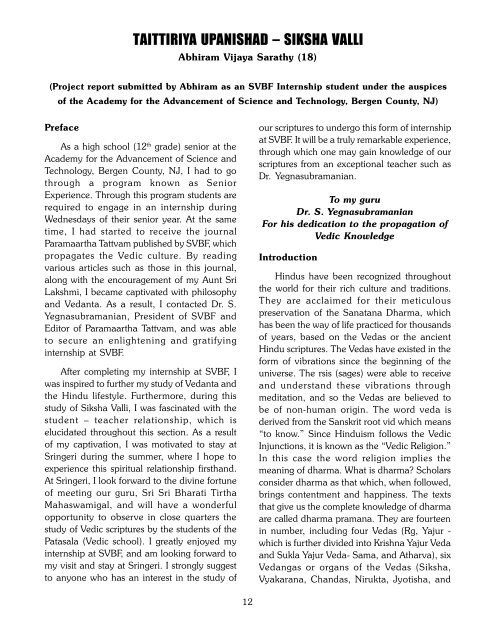
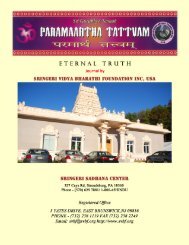
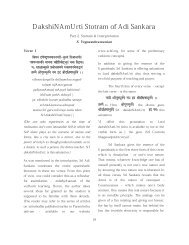
![Sri Venkatesha Karavalamba Stotram ô Ã;I ve±$ex kr;vlMb Sto]mà ô](https://img.yumpu.com/26953511/1/190x245/sri-venkatesha-karavalamba-stotram-a-ai-veaex-krvlmb-stoma-a.jpg?quality=85)
